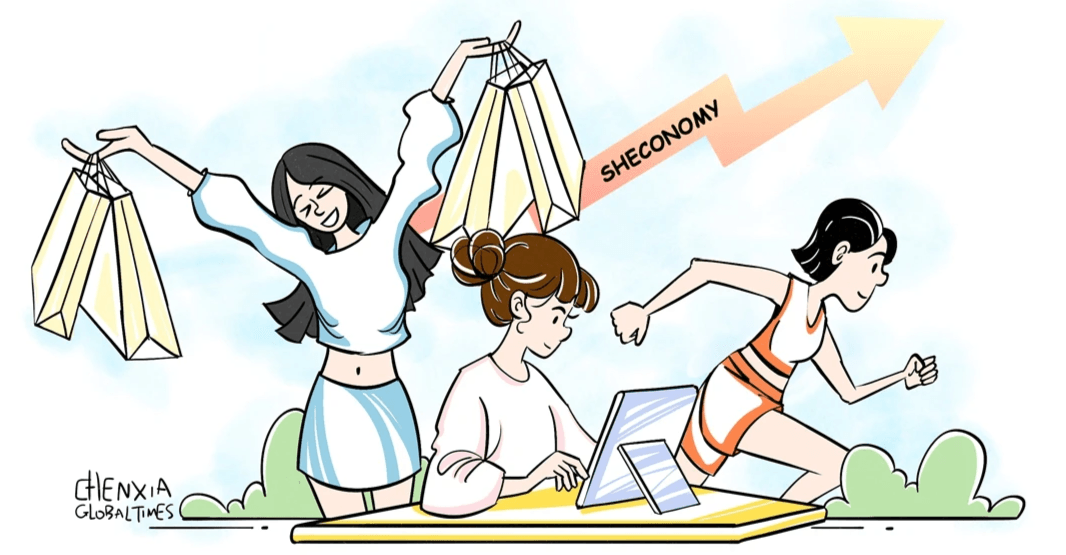Move Over Gentlemen, The Ladies Have The Credit Cards Now
Welcome to 2025, where Chinese women have graduated from being told what to buy to telling everyone else (including global markets) what's worth buying. What started as "letting women choose the household detergent brand" has evolved into "letting women control $1.4 trillion in annual spending while revolutionizing global consumption patterns." This isn't just shopping—it's economic domination with a feminine touch and occasionally some very expensive skincare.
The She Economy has transformed from marketing buzzword to economic superpower faster than you can say "add to cart." While economists were busy watching traditional indicators, 400 million Chinese women quietly became the consumer force that makes or breaks global brands with nothing more than their smartphone thumbs and discriminating taste.

The Numbers That Should Make Every CEO Pay Attention (And Possibly Panic)
Before we dive into the shopping habits that keep brand executives awake at night, let's look at some statistics that explain why your marketing strategy needs a serious feminine upgrade:
- Total Female Consumers: 400 million women ages 20-60 (roughly the entire population of the United States and Canada combined, all with shopping apps)
- Annual Spending Power: $1.4 trillion (approximately the GDP of Australia, but with better skincare routines)
- Household Purchase Control: 70% (meaning men think they make decisions until it actually matters)
- Female Internet Users: 624 million (a digital army larger than most continents' total population)
- Online Shopping Penetration: 92% among urban women (the other 8% probably have someone shopping for them)
The Fabulous Five: How Chinese Women Shop in Ways That Defy Logic (And Budgets)
1. Digital-First Consumption: Where Physical Stores Go to Die
The Smartphone Extension of Self:
In 2025, Chinese women have evolved beyond merely using smartphones for shopping—they've essentially merged with their devices in a retail symbiosis that makes Black Mirror episodes look quaint. Physical stores now exist primarily as backdrops for social media photos of products women will ultimately purchase online.
The Digital Reality:
- Mobile-First Approach: 98% shop primarily via smartphone (the other 2% are presumably still trying to remember their passwords)
- Preferred Platforms:
- Douyin E-commerce (where 15-second videos lead to 15 seconds of purchasing decision-making)
- Xiaohongshu (where women go to see what they should want before they know they want it)
- Tmall (the digital department store where paychecks go to die)
- WeChat Mini Programs (turning conversations about money problems into reasons for those money problems)
- Average Daily Online Shopping Time: 2.5 hours (longer than most people spend exercising in an entire week)
2. Hyper-Personalization: Because "One-Size-Fits-All" Is A Personal Insult
The Customization Obsession:
Chinese women in 2025 have developed such specific preferences that AI algorithms need therapy after trying to predict their needs. The concept of standard products has become as outdated as flip phones, with personalization now expected at a molecular level.
The Personalized Reality:
- AI-Driven Shopping: 85% rely on personalized recommendations (while complaining the AI "doesn't really understand me")
- Key Personalization Factors:
- Body type-specific fashion (because nothing says "I love myself" like clothes actually designed for your body)
- Skincare matched to individual skin concerns (addressing problems you didn't know you had until an app told you)
- Lifestyle-aligned product selections (so your purchases can judge your life choices before you do)
- Customization Premium: Willing to pay 30% more for personalized products (making custom products the highest-margin items since printer ink)

3. Wellness and Self-Improvement: Treating Your Body Like a Project That Never Ends
The Holistic Health Revolution:
The modern Chinese woman approaches wellness with the strategic planning of a military campaign and the budget of a small nation's defense spending. Self-improvement isn't a hobby—it's a competitive sport with products as equipment.
The Wellness Reality:
- Top Investment Categories:
- Premium skincare (because aging is now optional if you're willing to apply 17 products twice daily)
- Fitness technology (trackers that judge your daily steps with the disappointment of a tiger mom)
- Mental health resources (addressing the anxiety caused by trying to afford all these wellness products)
- Professional development courses (because personal and professional perfection must be achieved simultaneously)
- Organic and health-conscious products (foods so pure they make water feel self-conscious about its chemicals)
4. Social Commerce: Where Friendship Meets Aggressive Product Recommendations
The Influence Economy:
The line between socializing and shopping has disappeared so completely that Chinese women now maintain friendships and shopping carts simultaneously. Every conversation is a potential shopping recommendation, and every shopping experience is a social event.
The Social Shopping Reality:
- Influencer Impact: 76% of purchases influenced by KOLs (Key Opinion Leaders who have more sway over purchasing decisions than most religions)
- Community Shopping Trends:
- Group buying platforms (where peer pressure meets discount hunting)
- Real-time product reviews (where strangers' opinions matter more than your own experience)
- Interactive live-streaming commerce (QVC on digital steroids where hosts sell out warehouses in minutes)
- Average Monthly Social Commerce Spending: $450 (approximately one small apartment's rent in a third-tier city)
5. Sustainability and Ethical Consumption: Saving The Planet While Breaking The Bank
The Conscience Consumer:
Chinese women have developed environmental standards so high that most products require extensive therapy before meeting their expectations. Sustainability has evolved from a nice-to-have feature to an essential product characteristic that companies ignore at their peril.
The Ethical Reality:
- Sustainable Brand Preference: 68% prioritize eco-friendly brands (while occasionally flying to tropical vacations on carbon-spewing jets)
- Ethical Consumption Criteria:
- Carbon footprint (lower than your average houseplant)
- Transparent supply chains (knowing the life story of everyone who touched your product)
- Women-led businesses (supporting the sisterhood while depleting the brotherhood's bank accounts)
- Social responsibility initiatives (expecting brands to solve global problems while also offering free shipping)

How Not to Fail Miserably When Marketing to Chinese Women
Digital Engagement Tactics (Or "How to Avoid Digital Irrelevance")
- Platform-Optimized Content: Create WeChat and Douyin content so native it makes locals question if you're really foreign
- Interactive Digital Experiences: Develop engagement more addictive than scrolling through ex's photos
- AI-Powered Personalization: Use algorithms sophisticated enough to predict desires better than partners of 20 years
- Multi-Platform Journeys: Create seamless experiences across so many platforms your tech team develops insomnia
Content and Messaging (Or "Words That Won't Get You Canceled")
- Empowerment Emphasis: Celebrate female strength without sounding like you just discovered women have opinions
- Realistic Representation: Show diversity that reflects actual humans, not just 18-year-old models with impossible features
- Transparent Information: Provide product details comprehensive enough to satisfy conspiracy theorists
- Authentic Storytelling: Develop narratives genuine enough to make hardened cynics almost believe you
Product Development (Or "Creating Things Women Actually Want")
- Focus on Customization: If it can't be personalized, it might as well be invisible
- Wellness Integration: Add health benefits to products that previously had none (healthy laundry detergent, anyone?)
- Ethical Manufacturing: Ensure production methods pure enough to be mentioned in religious texts
- Digital-First Design: Create products that look good in real life but amazing on smartphone screens
The Crystal Ball: What's Next in the She Economy
Trends That Will Make Your Current Strategy Obsolete Before You Finish Reading This
- Web 3.0 Integration: Blockchain technology ensuring your luxury handbag purchase is more secure than most national elections
- Virtual Reality Shopping: Try-before-you-buy experiences so realistic you'll check if you're actually wearing the clothes
- AI Shopping Assistants: Digital companions that know your style better than you do and judge your choices with silent algorithm disapproval
- Hyper-Local Products: Micro-niche offerings so specific they're designed for single streets in particular neighborhoods
Conclusion: Resistance Is Futile (And Expensive)
The She Economy in China isn't just another market segment—it's an economic force of nature with the purchasing power of entire countries and the digital sophistication to make tech companies nervous. Brands that fail to understand, respect, and authentically engage with Chinese women aren't just missing an opportunity; they're planning their own obsolescence.
In this new economic order, the question isn't whether female consumers will transform your industry—it's whether you'll still be relevant when they're done revolutionizing it. The future of global commerce speaks Mandarin, shops on Douyin, cares deeply about ingredient lists, and has very, very specific opinions about skincare.
May your marketing strategies be as adaptable as they are authentic, and may your R&D department work as tirelessly as a woman hunting for the perfect foundation shade.